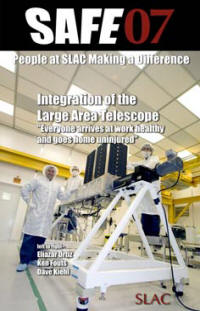
Handy Links
SLAC News Center
SLAC Today
- Subscribe
- Archives: Feb 2006-May 20, 2011
- Archives: May 23, 2011 and later
- Submit Feedback or Story Ideas
- About SLAC Today
SLAC News
Lab News
- Interactions
- Lightsources.org
- ILC NewsLine
- Int'l Science Grid This Week
- Fermilab Today
- Berkeley Lab News
- @brookhaven TODAY
- DOE Pulse
- CERN Courier
- DESY inForm
- US / LHC
SLAC Links
- Emergency
- Safety
- Policy Repository
- Site Entry Form

- Site Maps
- M & O Review
- Computing Status & Calendar
- SLAC Colloquium
- SLACspeak
- SLACspace
- SLAC Logo
- Café Menu
- Flea Market
- Web E-mail
- Marguerite Shuttle
- Discount Commuter Passes
-
Award Reporting Form
- SPIRES
- SciDoc
- Activity Groups
- Library
Stanford
Around the Bay
Safety Success Story: LAT Integration
 The primary instrument for the Gamma-ray Large Area Space Telescope (GLAST) mission,
the Large Area Telescope (LAT), will detect gamma rays with unprecedented sensitivity, offering exceptional insight into the nature of dark matter, stellar evolution and black holes. This instrument, currently undergoing environmental testing at General Dynamics in Phoenix, Arizona, was integrated at SLAC in 2005 and 2006 from hardware fabricated at laboratories all around the world. This very successful integration project was completed on time, on budget and—most importantly—safely.
The primary instrument for the Gamma-ray Large Area Space Telescope (GLAST) mission,
the Large Area Telescope (LAT), will detect gamma rays with unprecedented sensitivity, offering exceptional insight into the nature of dark matter, stellar evolution and black holes. This instrument, currently undergoing environmental testing at General Dynamics in Phoenix, Arizona, was integrated at SLAC in 2005 and 2006 from hardware fabricated at laboratories all around the world. This very successful integration project was completed on time, on budget and—most importantly—safely.
"Our disciplined approach led to a safe working environment," said LAT Project Manager Ken Fouts. "At our daily morning meetings, the first item on the agenda every single day was safety. This set the tone for the rest of the day: safety comes first. Our people deserve the opportunity to arrive at work healthy and go home without injuries at the end of the day. We look out for ourselves, but more importantly, for each other."
One of the main reasons the project was concluded with a stellar safety record is the team's unwavering dedication to planning. The majority of the safety concerns on the integration project revolved around lifting and integrating components very precisely. The team completed hundreds of lifts that all needed to be done safely and very carefully, as many of the lifts required working in a confined space.
To ensure safety, all lifts and critical component moves were thoroughly considered, documented and rehearsed before they took place. For example, prior to beginning the installation of the instrument's 16 flight trackers, the mechanical team developed a detailed process based on the assembly drawing that would allow them to carefully—and safely—install the tracker onto the rest of the LAT. They created a detailed written procedure that included each step required to complete the lift and installation, identifying hazards and possible safety issues along the way.
The mechanical team then used this documentation to dry-run the lift and installation process, using an engineering model of the tracker, an exact replica of the flight version, to ensure that they had identified all hazards and that the procedure could be executed safely. The procedure was "red-lined" during the dry-run to include additional detail or to clarify steps to make the procedure safer. Once the written procedure was updated, it was submitted for release, requiring a review and sign-off by the appropriate technical manager, product assurance inspector and safety representative. The procedure sign-off is a work authorizing process that helps ensure that the entire team is aware of the steps required to safely and successfully execute the integration steps prior to the work being performed.
When it came time to install the flight equipment, the team followed the written documentation to the letter, with the operator and a product assurance inspector signing off each step of the process as it was completed with a note of who completed that step and when it was accomplished.
"We then followed this same procedure for each of the instrument's other 15 trackers," said Fouts. "By following the same steps each time—and working from the written documentation and not from memory—we have a disciplined and consistently successful process that resulted in the safe installation of all the trackers without a hitch."
The team followed this process not only for every tracker, but for every lift and critical movement in the integration process—both at SLAC and beyond. The LAT has moved quite a bit since it was integrated at SLAC. The instrument's environmental testing was completed at the Naval Research Laboratory in Washington, D.C., in September of 2006 and has since moved to General Dynamics in Phoenix to complete system level environmental tests. SLAC staff working with the instrument at each location implemented the same high level of planning to ensure their safety.
"The impression is that this process takes a little bit longer, but it provides safety for people and for system hardware and in the end it saves time because we minimize accidents," said Fouts. "By documenting and rehearsing the procedure before doing the real one, we use disciplined planning to help make sure that everything goes according to plan."
—Kelen Tuttle, SLAC Today, October 31, 2007